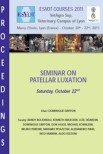Objectives: To describe the surgical technique and clinical outcomes of distal femoral shortening osteotomy (DFSO) to facilitate prosthesis reduction in dogs with irreducible luxoid hips undergoing total hip replacement (THR).
Animals: Four client-owned dogs with luxoid hips.
Study design: Short case series.
Methods: Standard THR was performed to alleviate pain and restore limb function. After confirming the prostheses were non-reducible, DFSO was performed as a novel tension-relieving technique at a level that allowed internal fixation. The shortening length was determined by the intraoperative tension required to reduce and maintain the prosthesis. Data from medical records were collected, including signalment, clinical signs, implant used, shortening length, and outcomes.
Results: Following DFSO, prosthesis reduction was successful in all dogs. The median femoral shortening length ratio was 13.8% (range, 10.7%-15.3%). One intraoperative complication involved a fissure of the greater trochanter, which occurred during trial reduction before DFSO. Median duration of follow-up was 21 months (range, 3-34 months). Two dogs showed good to excellent limb function. Bone union was consistently achieved in all DFSO procedures. Two postoperative complications were observed: one case of prosthesis luxation and one case of aseptic stem loosening. The owner declined revision surgery for luxation, and explantation was performed for the stem loosening.
Conclusion: DFSO could effectively manage irreducible prostheses in dogs with luxoid hips when conventional methods fail. However, careful case selection and meticulous surgical planning were essential to avoid complications.









